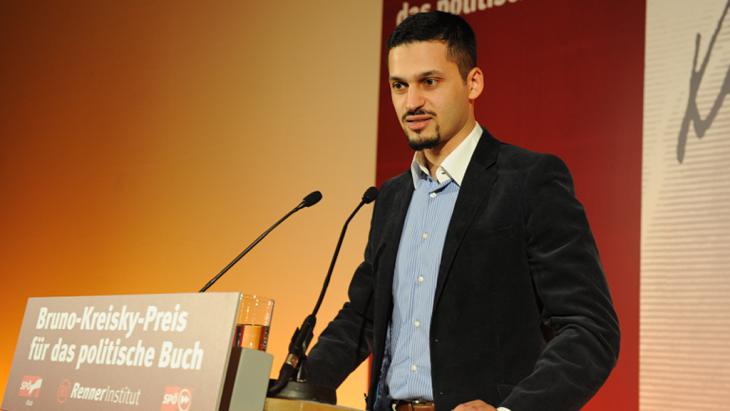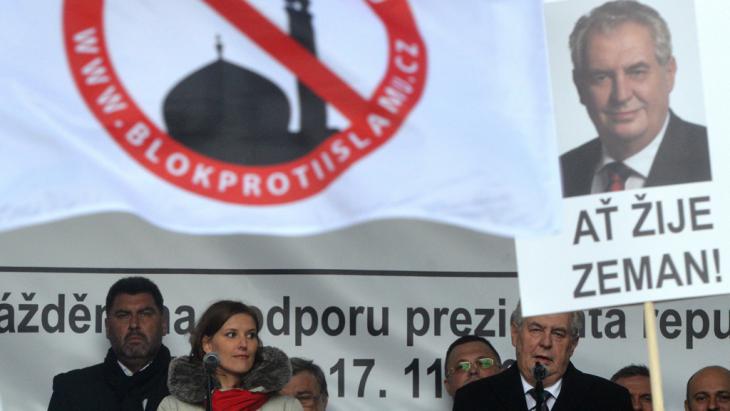Wake up to the danger!

Dead pigs left on the grounds of mosques, anti-Muslim PEGIDA demos, assaults on women wearing headscarves and arson attacks against Muslim institutions. These are just a few recent examples of anti-Islamic racism. The anti-Muslim mood in Europe and the number of assaults have risen sharply. Right-wing populists are attracting a large following and stereotyped images of Muslims are becoming more widespread, even at the very centre of society. This is the conclusion reached by the first European Islamophobia Report, which was presented to the European Parliament in Brussels in May.
On behalf of the Turkish think tank SETA, scholars from 25 countries gathered extensive data on Islamophobia and anti-Muslim racism. By publishing this abundant material, the two political scientists Enes Bayrakli from the Turkish-German University in Istanbul and Farid Hafez from the University of Salzburg want to draw the attention of policymakers and the public to a phenomenon that many have thus far not taken seriously enough. "The existence of Islamophobia in Europe can now no longer be denied," says Farid Hafez. "600 pages of documentation clearly demonstrate that we have a problem."
Islamophobia is not the same as criticism of Islam
The term Islamophobia is quite controversial in the social sciences, where some find it too ambiguous. A frequent criticism is that labelling something "Islamophobic" is a way to circumvent any form of criticism of Muslims, Muslim associations or Islam. The European Islamophobia Report starts off with a disambiguation in order to distinguish between stirring up racist hatred based on resentment and an enlightened critique, which is not only legitimate, but a necessary part of the intellectual debate.
Islamophobia should thus not be equated with criticism of Islam, as the authors make quite clear. Rather, they define Islamophobia as "constructing a static 'Muslim' identity, which is attributed in negative terms and generalised for all Muslims."
It is nevertheless debatable in certain cases whether a statement constitutes legitimate religious criticism or is already predicated on an Islamophobic stereotype. Islamophobic images are fluid and vary in different contexts.

They serve above all to construct an image of a "we", the majority society, versus the Muslims as a foreign counterpart, as the Other. It comes down to the power wielded by a dominant group of people in order to deprive a minority of their legitimate rights and participation in social resources.
Most of the victims are women
Based on a wealth of data, the report demonstrates a significant increase in Islamophobic sentiment in Europe last year. 2015 was the year of the attack on the French satirical magazine Charlie Hebdo and the terrorist attack in Saint Denis. And in autumn of 2015, the so-called refugee crisis reached a high point. For Farid Hafez, these three events were the decisive triggers for the spread of Islamophobic discourse in Europe.
The scholars examined various areas of life. Are Muslims discriminated against on the job market? Do curricula, textbooks or other materials in educational institutions contain Islamophobic content? What role does Islamophobia play in elections and in the political programmes of the various parties? What is the media coverage like? Does the legal system include laws and regulations designed to hinder Muslims from practising their religion? Are there hate pages on the Internet and what role do they play in the public debates?
In France, the country with the largest Islamic minority in Europe, the organisation "Collectif Contre l'Islamophobie en France" recorded a significant increase in attacks on mosques, Islamic institutions and Muslims in the first six months of 2015. Such incidents were up by 500 percent, including both verbal and physical attacks. All cases of physical assault were counted that left the victims unable to work for at least eight days. Two-thirds of the victims were Muslim women. In Germany, no reliable figures are available for Islamophobic attacks, because they are not separately recorded. In the period from January to October 2015, however, there were some 850 attacks on asylum facilities, in which 13 people were injured.
In addition to the openly anti-Islamic PEGIDA demonstrations, something else is striking in Germany: the concept of the Judeo-Christian culture is often brought into the public debate. This serves to exclude Muslims as ostensibly belonging to a culture that can never be compatible with European values, while at the same time conveniently ignoring the Holocaust.
Islamophobia without Muslims
Islamophobia also works without the presence of Muslims, as demonstrated by the data and analyses from the ten countries of Eastern Europe. This focus is what is actually new about the report, as previous studies examined solely Western Europe. The Muslim communities living in Hungary, Lithuania, Latvia and Poland are quite small and yet Islamophobia there serves as a successful "means of mobilising people" politically.

In the countries of the former Eastern bloc, anti-Islamic stereotypes are blatantly used for political propaganda and not only by right-wing extremists and Islam-hostile opposition parties as in Western Europe. A particularly dramatic example of this is the statement made by the Social Democratic Czech President Milos Zeman claiming that the influx of refugees into Europe had been masterminded by the Egyptian Muslim Brotherhood and could be characterised as an "organised invasion" with the aim to "gradually control Europe".
The data also shows that Muslim women "are affected the most by Islamophobia when they can be identified as Muslims, for example by wearing a headscarf," says Farid Hafez. The headscarf is an obstacle in particular when it comes to finding a job, no matter where the women may live in Europe. And Muslim women also suffer from their stereotypical representation in the media and in public debates, which portray them as oppressed. For Farid Hafez, racism "always has a sexist component". This finds expression in the notion of the Islamic woman "who must be liberated".
Despite the large number of documented abuses, it can be assumed that many anti-Muslim incidents are not reported. This makes agencies such as the Austrian "Dokustelle Muslime" and the initiative "Meld Islamophobie" in the Netherlands all the more important. The authors of the report call for hate crimes against Muslims to be recognised as an offence. Such crimes have to date not been separately recorded in most European countries, but in Germany this was to be done starting this year.
The developments in 2016 have thus far shown just how perilous anti-Muslim racism is for social peace. Islamophobia greatly jeopardises the democratic foundations of European constitutions as well as the peaceful coexistence of different cultures. Politics and civil society need to finally start taking this danger more seriously.
Claudia Mende
© Qantara.de 2016
Translated from the German by Jennifer Taylor